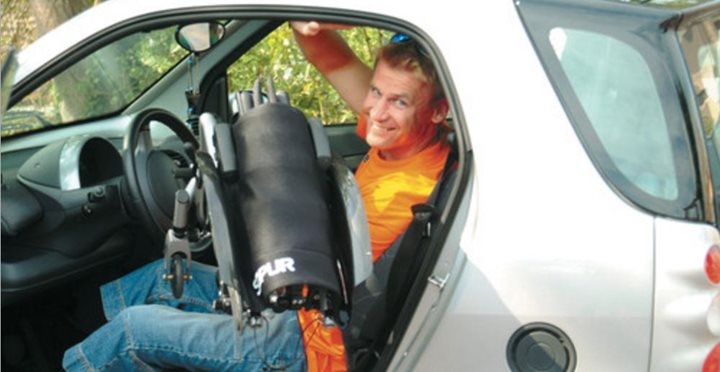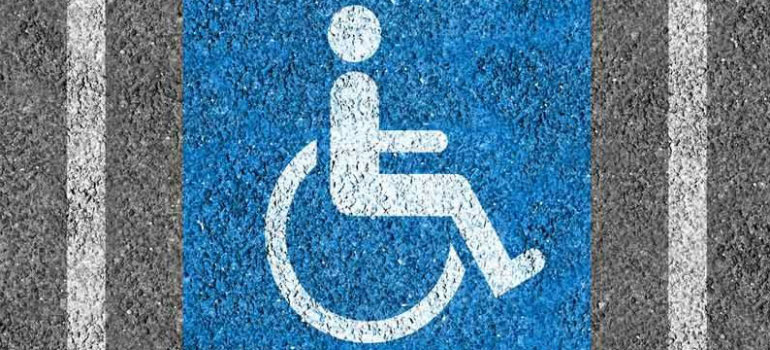Share:
Take it offline!
This Education in Motion resource is also available as a printable PDF.
Download PDF
In the UK, a parking permit for disabled drivers or passengers is referred to as a Blue Badge. The permits are valid for three years and are usually issued to those who have a registered disability which affects their mobility. If you are registered as blind, you will also automatically qualify for the Blue Badge scheme. The parking permit may be used to park in disabled spaces in the UK and in all countries within the European Union and the European Economic Area.

How to apply for a Blue Badge
If you are based in England or Wales, you should apply for a Blue Badge on the GOV.UK website or in person via your local council (you may be charged an extra fee for this). Scotland and Northern Ireland have their own websites. The application fee depends on the country in which you are living. Aside from the routes mentioned above, there is no way to legally obtain a disabled parking permit. Any other websites or companies offering this possibility may be fraudulent, so please do not use them.
You will need to provide the following to apply for or renew your Blue Badge permit:
- The details of your current Blue Badge (if you have one)
- A digital or signed photo
- Your National Insurance or NHS number
- Proof of identification
- Proof of UK residency
Eligibility criteria
The specific criteria used to assess eligibility are as follows. If any of the below apply, you must provide evidence in the application form, along with proof of your identity and residency. You will not, however, have to visit your local authority in person to attend a mobility assessment. You are eligible if:
- You have either a Certificate of Vision Impairment (CVI) or a BD8 form, signed by a consultant ophthalmologist, stating that you are severely sight impaired (blind) and wish to be registered as severely sight impaired (blind) with your local authority.
- You receive the Higher Rate of the Mobility Component of the Disability Living Allowance.
- You receive a Personal Independence Payment (PIP) as you meet a 'Moving Around' descriptor for the Mobility Component because you either cannot stand or can stand but walk no more than 50 metres. This is a score of 8 points or more.
- You receive a War Pensioners' Mobility Supplement.
- You receive a tariff within 1-8 (inclusive) of the Armed Forces Compensation Scheme and have been assessed as having a permanent and substantial disability which causes inability to walk or very considerable difficulty in walking.

Further criteria
In the following instances, you may be eligible, but will first have to attend a mobility assessment.
- You are over the age of two and have a permanent and substantial disability which means that you are unable to walk
- You are over the age of two and have a permanent and substantial disability which means that you have very considerable difficulty in walking
- You drive a vehicle regularly, and have a severe disability in both arms that means you are unable to operate all or some types of parking meter
- You are under the age of three and have a medical condition that means you must always be accompanied by bulky medical equipment
- You are under the age of three and have a medical condition that means you must always be kept near a vehicle in case you need emergency medical treatment
Once you have applied online, you can track and amend your application if necessary. If your application is unsuccessful, your local council should inform you of the reasons why. You can appeal if you feel the wrong decision has been made, or if your mobility worsens.

Displaying your permit
There is only one type of permit available, and it is very important that you display the Blue Badge face up on your windscreen. The expiry date must not be obscured. Some rightful permit holders have been given parking tickets because the date on their Blue Badge was partially covered.
Some car parks have a maximum time limit for their disabled bays and hand out disabled parking disks when you enter. These require you to adjust the disc until it shows your time of arrival. If you do receive a parking disc, it is very important that you make sure it does not cover your Blue Badge when you place it on your windscreen.
Using your Blue Badge
A Blue Badge allows a driver to park in disabled bays around the UK, but it is linked to the holder, not the vehicle. This means that Blue Badge holders may use it in a hire car as well as their own vehicle. If a person in possession of a Blue Badge is travelling as a passenger, or is being picked up by someone, the driver of that vehicle may park in a disabled bay.
In addition to this, a Blue Badge normally allows you to park for free on streets with parking meters or pay-and-display machines. In private car parks, however, such as at hospitals or shopping centres, you will usually have to pay even if you have a valid Blue Badge.
A further benefit is that you may park on single or double yellow lines for up to 3 hours. In some cases, there may be a ‘no loading’ sign displayed. Some councils allow Blue Badge holders to park in spite of the ‘no loading’ instruction and some do not. It is worth checking the website of your local council to find out their policy.
Disabled parking bays
Although disabled parking bays do not all look the same, they tend to have some features in common. There will normally be a white sign nearby with two blue squares on it: one with a white parking ‘P’ symbol inside and the other with a white standardised image of a wheelchair user. Disabled bays are almost always wider than normal parking spaces to make it easier for the Blue Badge Holder to get in and out of their vehicle.

The standardised image of a wheelchair user is usually painted in the middle of disabled bays. The bays themselves are generally painted in a different colour to regular parking spaces. The lines used to mark them out are often painted yellow (and sometimes blue), and many of them also have diagonal lines which cross one another. Sometimes, these lines are painted using non-slip paint.
Badge Holders may also request that their local council paint a disabled bay outside their home. In such cases, the council often paints broken white lines to mark out the bay along with the word ‘DISABLED’. In private car parks, meanwhile, the disabled spaces tend to be located nearer to the entrance of the destination building. The colour they are painted varies.